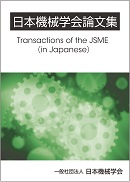Volume 81, Issue 824
Displaying 51-69 of 69 articles from this issue
Thermal, Engine and Power Engineering
-
2015 Volume 81 Issue 824 Pages 14-00641
Published: 2015
Released on J-STAGE: April 25, 2015
Advance online publication: March 18, 2015Download PDF (1383K) -
2015 Volume 81 Issue 824 Pages 15-00030
Published: 2015
Released on J-STAGE: April 25, 2015
Advance online publication: March 18, 2015Download PDF (1527K)
Dynamics & Control, Robotics & Mechatronics
-
2015 Volume 81 Issue 824 Pages 14-00351
Published: 2015
Released on J-STAGE: April 25, 2015
Advance online publication: March 27, 2015Download PDF (1061K) -
2015 Volume 81 Issue 824 Pages 14-00457
Published: 2015
Released on J-STAGE: April 25, 2015
Advance online publication: February 06, 2015Download PDF (3476K) -
2015 Volume 81 Issue 824 Pages 14-00474
Published: 2015
Released on J-STAGE: April 25, 2015
Advance online publication: March 16, 2015Download PDF (2595K) -
2015 Volume 81 Issue 824 Pages 14-00517
Published: 2015
Released on J-STAGE: April 25, 2015
Advance online publication: February 27, 2015Download PDF (1240K) -
2015 Volume 81 Issue 824 Pages 14-00576
Published: 2015
Released on J-STAGE: April 25, 2015
Advance online publication: March 04, 2015Download PDF (2377K) -
2015 Volume 81 Issue 824 Pages 14-00578
Published: 2015
Released on J-STAGE: April 25, 2015
Advance online publication: February 27, 2015Download PDF (2506K) -
2015 Volume 81 Issue 824 Pages 14-00644
Published: 2015
Released on J-STAGE: April 25, 2015
Advance online publication: March 16, 2015Download PDF (1494K) -
2015 Volume 81 Issue 824 Pages 14-00678
Published: 2015
Released on J-STAGE: April 25, 2015
Advance online publication: March 04, 2015Download PDF (1783K)
Micro/Nano Science and Technology
-
2015 Volume 81 Issue 824 Pages 14-00652
Published: 2015
Released on J-STAGE: April 25, 2015
Advance online publication: March 12, 2015Download PDF (1343K)
Design, Systems, and Manufacturing
-
2015 Volume 81 Issue 824 Pages 14-00481
Published: 2015
Released on J-STAGE: April 25, 2015
Advance online publication: March 06, 2015Download PDF (17678K) -
2015 Volume 81 Issue 824 Pages 14-00618
Published: 2015
Released on J-STAGE: April 25, 2015
Advance online publication: February 20, 2015Download PDF (4652K) -
2015 Volume 81 Issue 824 Pages 14-00656
Published: 2015
Released on J-STAGE: April 25, 2015
Advance online publication: February 26, 2015Download PDF (3134K)
Bio, Medical, Sports and Human Engineering
-
2015 Volume 81 Issue 824 Pages 14-00488
Published: 2015
Released on J-STAGE: April 25, 2015
Advance online publication: March 06, 2015Download PDF (1691K) -
2015 Volume 81 Issue 824 Pages 14-00543
Published: 2015
Released on J-STAGE: April 25, 2015
Advance online publication: March 06, 2015Download PDF (2365K) -
2015 Volume 81 Issue 824 Pages 14-00692
Published: 2015
Released on J-STAGE: April 25, 2015
Advance online publication: March 18, 2015Download PDF (4039K)
Transportation and Logistics
-
2015 Volume 81 Issue 824 Pages 14-00663
Published: 2015
Released on J-STAGE: April 25, 2015
Advance online publication: February 26, 2015Download PDF (2885K)
Space Engineering
-
2015 Volume 81 Issue 824 Pages 14-00298
Published: 2015
Released on J-STAGE: April 25, 2015
Advance online publication: March 26, 2015Download PDF (4123K)
